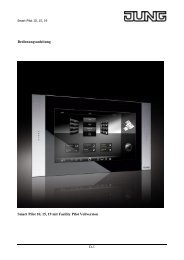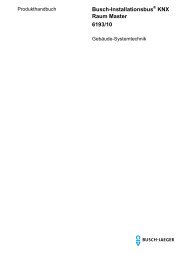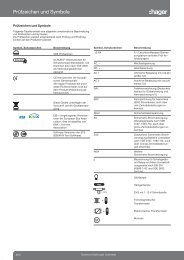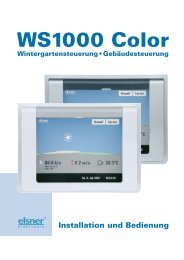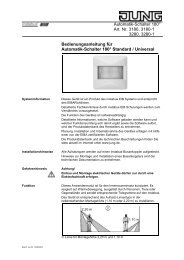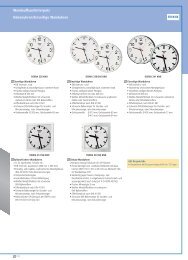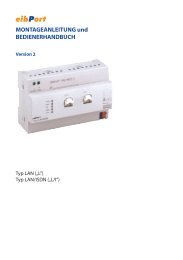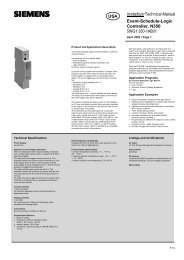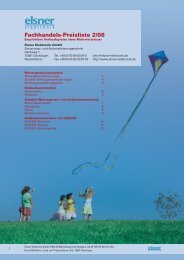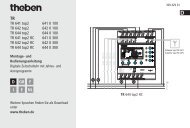Create successful ePaper yourself
Turn your PDF publications into a flip-book with our unique Google optimized e-Paper software.
4.2.4.11 Presence simulation<br />
Introduction<br />
The presence simulation can give those outside the impression that a house or office block is<br />
occupied, especially when there is no-one inside. The owners or operating personnel can record<br />
any simulations, for example for lighting or shading, over periods of time and play them<br />
back when they are not there.<br />
The recording records KNX/EIB telegrams in the 1 bit and 1 byte data formats and temporarily<br />
saves them with time and weekday information. On playing back, the previously saved telegram<br />
sequence can either be played back with accurate times or, alternatively, with accurate times<br />
and weekdays.<br />
The presence simulation is operated on the system page of the same name in the panel. This<br />
system page can be jumped to using the Open page function button. Operation of the presence<br />
simulation makes a key distinction between the recording and the playing back of a telegram<br />
sequence.<br />
4.2.4.11.1 Recording a telegram sequence<br />
Select functions<br />
The presence simulation records telegrams received from the KNX/EIB. For this, the project<br />
planner must create special recording objects, which are independent from the rest of the panel<br />
project planning, in the ETS plug-in. A recording object can be added by clicking the right<br />
mousebutton in the "Presence simulation" parameter node. Up to 32 objects can be created in<br />
this way.<br />
In the parameter group of a recording object, a clear designation can be assigned (e.g. "Seating<br />
group light" or "Roller shutter, living room"), which can then be read off on the panel by the operator.<br />
In addition, the required data format of the recording object must be configured. The two<br />
formats "DPT 1,001 (i bit switching)" and "DPT 5,001...5,004 (1 byte value)" are available. Addition<br />
parameter configuration are not required in the ETS plug-in for the presence simulation.<br />
Before the presence simulation can be used, the operator must record a sequence of telegrams<br />
on the panel. For this, the operator must switch to the "Presence simulation" system page (see<br />
picture 32).<br />
Order-No. 7574 00 1X<br />
picture 32: System page of the presence simulation<br />
Software "...590101"<br />
Functional description<br />
In the first step, the functions must be selected which are to be included in the presence simulation.<br />
The functions are defined as the recording objects, previously created in the device project<br />
planning and linked with group addresses, and the building units controlled by them. The term<br />
"Functions" is used instead of "Objects" on the user control interface, as the switching or value<br />
telegrams configured in the ETS project execute specific functions, i.e. switching lights or controlling<br />
a shading situation.<br />
Pressing the "Select functions" button on the system page of the presence simulation (see picture<br />
32) opens the page "Presence simulation channel selection" (see picture 33).<br />
Page 105 of 222




